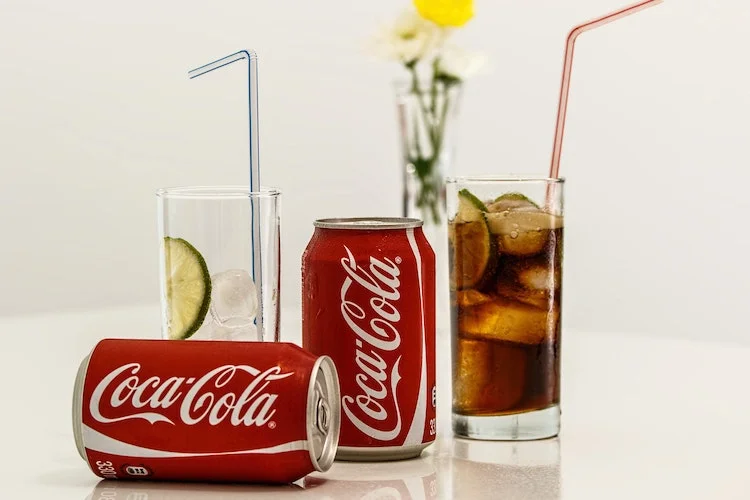Coca-Cola is one of the largest beverage companies in the world, serving over 1.9 billion drinks daily. Despite its roots as a single-product company, selling soda at a drugstore for five cents a glass, it now boasts a portfolio of 200 brands, including Coke, Fanta, and Sprite. With declining soda consumption in the US, the company has shifted its focus, making investments in the sports performance drink market with Body Armor and acquiring UK coffee maker Costa.
Despite the pandemic’s impact in first quarter of 2021, Coca-Cola reported a 5% increase in net revenue to $9 billion. The company has focused on improving its marketing and cutting its brand portfolio in half, while also prioritizing innovation and working with bottlers to support customers in new ways. These efforts, along with a recent reorganization, have allowed the company to return to pre-pandemic levels.
Coca-Cola’s origin can be traced back to a soda fountain in Atlanta, Georgia. In 1886, pharmacist John Pemberton created a caramel-colored syrup and took it to a nearby drugstore, where carbonated water was added, resulting in a drink that was sold for five cents a glass. The mixture contained caffeine, high levels of sugar, and for a few years, a small amount of coca leaf extract, meaning cocaine, according to author Mark Pendergrast. In its early days, Coca-Cola was advertised as a medicine and was claimed to cure addiction to morphine, among other things, but ultimately this was not successful. In 1888, the recipe was sold to a wealthy businessman named Asa Candler, and by 1895, Coca-Cola was available in every state in the US.
In the 1920s and 1930s, Coca-Cola transformed into a widely popular American soft drink and expanded into new markets abroad. During World War II, it was exempt from sugar rationing and supported the GIs by establishing 64 portable bottling plants around the world and distributing more than 5 billion bottles of Coca-Cola. The company continued to innovate by launching its first diet drink in 1971, airing the famous “I’d like to Buy the World a Coke” commercial in 1982, and introducing Diet Coke in the same year.
In 1985, Coca-Cola attempted to increase sales and compete with competitor Pepsi by introducing a new formula for their classic soda, called New Coke. However, the move was met with widespread criticism and disappointment from both fans and experts. The company quickly realized their mistake and brought back the original formula after just 79 days.
Impact of health concerns and the pandemic on coca cola
In the 1990s, the consumption of sugar-sweetened drinks in the US was increasing. However, a bigger challenge was about to emerge for Coca-Cola and other beverage companies. In the early 2000s, consumer focus shifted towards health and wellness, leading to a decline in soda consumption. The peak in consumption was reached in the early 2000s in terms of per capita consumption and has been decreasing since then. This decrease in carbonated soft drinks consumption was accompanied by growing concerns about sugars and simple carbohydrates.
Despite the decline, people still had a fondness for soda. Between 2011 and 2014, almost half of US adults consumed at least one sugar-sweetened drink daily. According to IBISWorld, the soda market in the US is valued at $38.5 billion and includes major players such as PepsiCo, Keurig Dr. Pepper, and Coca-Cola.
PepsiCo reported a net sales increase of over $14.8 billion in the first quarter of 2021, a rise of almost 7% compared to the previous year. The boost in sales was due to the pandemic-fueled snacking in the Frito Lay division and an increase in the sales of beverages like Bubly sparkling water and Starbucks ready-to-drink coffee. Keurig Dr. Pepper’s coffee business also experienced growth, with the company reporting first quarter 2021 net sales of $2.9 billion, an increase of more than 11% from the prior year.
Despite a decline in net revenue by 11% in 2020, Coca Cola made a comeback in the first quarter of 2021 with a net revenue of $9 billion, a 5% increase from the previous year. The company has been significantly impacted by the pandemic and is still recovering, but feels confident about the guidance set for its top and bottom line and believes it will emerge stronger from the crisis.
However, Coca Cola faces a major challenge as it has more exposure to restaurants like McDonald’s and sports venues compared to its competitors, PepsiCo and Keurig Dr. Pepper. This means that they lost a large portion of their market share as these channels closed, causing a disproportionate impact on their revenue and market share. To counteract this loss, the soft drink maker reduced its global workforce by 11% and narrowed its brand portfolio from 400 to 200, including the discontinuation of its first diet soda, Tab.
Analysts believe that Coca Cola has several key strengths that will enable it to revive its business. Firstly, its widespread geographical presence will ensure a consistent source of growth for the company. Coca Cola’s products are available in more than 200 countries and territories around the world, and the company boasts one of the largest non-alcoholic beverage distribution systems globally. Additionally, over 40% of Coca Cola’s sales come from developing and emerging economies with a growing middle class. In 2020, the company generated net operating revenue of $33 billion, with two-thirds of that amount coming from outside the US. In developed markets, where competition is high, Coca Cola has established a track record of profitable growth through innovative strategies.
In the US, despite a decline in soda consumption, the value of the category continues to grow. One strategy employed by Coca Cola is “price pack architecture,” which refers to consumers’ willingness to pay extra for packaging innovations. The company has discovered that consumers prefer smaller drinks and are willing to pay more per ounce for them. Furthermore, Coca Cola has positioned itself in a part of the supply chain that requires less capital, labor, and overhead than rival beverage companies like Pepsi.
The challenges of plastic pollution and water usage
The majority of Coca Cola’s well-known beverages are not packaged and delivered directly by the company. Instead, Coca Cola focuses on producing the concentrate for its drinks and sends the mixtures to bottlers for further processing, packaging, and distribution.
In 2020, environmental organization Break Free From Plastic conducted a worldwide audit of plastic waste, in which over 15,000 volunteers in 55 countries collected plastic bottles, coffee cup lids, shampoo bottles, and surgical masks during a two-month cleanup. The group stated that for the third consecutive year, Coca Cola emerged as a leading contributor to plastic pollution, with nearly 14,000 Coca Cola-branded plastics found in 51 countries. As of 2018, Greenpeace reported that Coca Cola has produced over 110 billion single-use plastic bottles. The organization estimates that in the ten years leading up to 2018, the company reduced its plastic bottles by around a third, making up approximately 70% of Coca Cola’s packaging globally. Despite the fact that Coca Cola is not the only multinational corporation reliant on plastic packaging, the sheer size of the company highlights the extent of the issue. Other significant contributors to plastic pollution, according to Break Free From Plastic, include PepsiCo, Nestle, Unilever, Mondelez International, and Mars.
According to a report by the World Economic Forum, an estimated 8 million tons of plastic end up in the oceans each year, the equivalent of dumping a garbage truck of plastic into the oceans every minute. Plastic packaging constitutes a significant part of this problem. To help tackle this issue, Coca Cola has committed to using 50% recycled material in its bottles and cans by 2030 and to collect or recycle one bottle or can for every one sold by the same date. The company also introduced a plastic bottle made up of 30% plant-based materials in 2009, and in 2020, teamed up with Danish start-up Pabaco to develop a 100% paper bottle. However, this project is still in its early stages, and some critics argue that it may not be enough to address the problem, due to the high costs of recycling and the fact that less than 50% of plastic is recycled globally.
Another issue that Coca Cola faces is its water usage. Approximately one-third of its bottling plants are located in areas facing water scarcity, and more than 73% of the water used by the company goes into growing ingredients like cane sugar, oranges, and apples. To enhance its water efficiency, the company has reduced or removed water from its manufacturing process. By 2018, it was using 1.92 liters of water to produce one liter of product, compared to 2.7 liters used in 2004. In 2016, the company also announced that it was replenishing watersheds and working with organizations to return water to local communities.
Adaptation to changing consumer trends and investment
In 2020, the sales of Coca Cola’s sparkling soft drinks faced a 4% decline. The shift towards e-commerce in the beverage industry has been evident, with consumers adapting to online shopping and takeaways. This trend is expected to continue and is not limited to just home deliveries, but also to away-from-home channels.
However, it is the new product offerings that might have the most significant impact on the soft drink giant. As per the research conducted by Morningstar, roughly 25% of Coca Cola’s revenue in 2020 was generated from new or reformulated products, such as Coke Zero and Coke Energy, compared to approximately 15% two years prior. The company’s focus on innovation in its product portfolio could drive future growth.
Coca Cola’s efforts to diversify its product portfolio have been evident in recent years, as the company has made investments in sports drinks, coffee and more. These acquisitions and investments seem to be paying off, with 25% of the company’s revenue in 2020 being generated from new or reformulated products, as reported by Morningstar. Additionally, the global coffee market is growing 6% annually, offering the company further growth opportunities. With the shift towards health and wellness concerns, Coca Cola’s continued efforts to innovate its traditional soda business could also bring significant gains for the company. Overall, Coca Cola’s diversification strategy and efforts to stay ahead of consumer trends seem to be paying off and bode well for the company’s future growth prospects.

 Starbucks Rise to an $80 Billion Business
Starbucks Rise to an $80 Billion Business